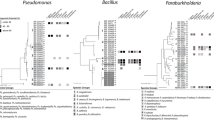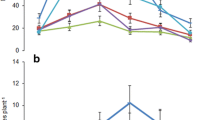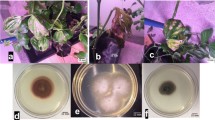Abstract
In agriculture, horticulture and plantation forestry, Bacillus species are the most commonly applied antagonists and biopesticides, targeting plant pathogens and insect pests, respectively. Bacillus isolates are also used as bacterial plant biostimulants, or BPBs. Such useful isolates of Bacillus are typically sourced from soil. Here, we show that Bacillus – and other antagonistic microbes – can be sourced from a broad range of plant seeds. We found that culturable Bacillus isolates are common in the seeds of 98 plant species representing 39 families (i.e., 87% of the commonly cultured bacteria belonged to Bacillales). We also found that 83% of the commonly cultured fungi from the seeds of the 98 plant species belonged to just three orders of fungi—Pleosporales, Hypocreales and Eurotiales—that are also associated with antagonism. Furthermore, we confirmed antagonism potential in agaro with seed isolates of Bacillus from Pinus monticola as a representative case. Eight isolates each of seed Bacillus, seed fungi, and foliar fungi, all from P. monticola, were paired in a total of 384 possible pair-wise interactions (with seed and foliar fungi as the targets). Seed Bacillus spp. were the strongest antagonists of the seed and foliar fungi, with a mean interaction strength 2.8 times greater than seed fungi (all either Eurotiales or Hypocreales) and 3.2 times greater than needle fungi. Overall, our study demonstrates that seeds host a taxonomically narrow group of culturable, antagonistic bacteria and fungi.



Similar content being viewed by others
References
Bar-On YM, Phillips R, Milo R (2018) The biomass distribution on Earth. Proc Natl Acad Sci 115(25):6506–6511
Kearney J (2010) Food consumption trends and drivers. Philos trans royal soc B biol sci 365(1554):2793–2807
Reese AT, Chadaideh KS, Diggins CE, Schell LD, Beckel M, Callahan P, Ryan R, Thompson ME, Carmody RN (2021) Effects of domestication on the gut microbiota parallel those of human industrialization. Elife 10:e60197
Raghavendra AKH, Newcombe G, Shipunov A, Baynes M, Tank D (2013) Exclusionary interactions among diverse fungi infecting developing seeds of Centaurea stoebe. FEMS Microbiol Ecol 84(1):143–153
Shipunov A, Newcombe G, Raghavendra AK, Anderson CL (2008) Hidden diversity of endophytic fungi in an invasive plant. Am J Bot 95(9):1096–1108
Hamid B, Zaman M, Farooq S, Fatima S, Sayyed RZ, Baba ZA, Sheikh TA, Reddy MS, El Enshasy H, Gafur A, Suriani NL (2021) Bacterial Plant Biostimulants: A Sustainable Way towards Improving Growth, Productivity, and Health of Crops. Sustainability 13(5):2856
Chaurasia B, Pandey A, Palni LMS, Trivedi P, Kumar B, Colvin N (2005) Diffusible and volatile compounds produced by an antagonistic Bacillus subtilis strain cause structural deformations in pathogenic fungi in vitro. Microbiol Res 160(1):75–81
Dong YH, Zhang XF, Xu JL, Zhang LH (2004) Insecticidal Bacillus thuringiensis silences Erwinia carotovora virulence by a new form of microbial antagonism, signal interference. Appl Environ Microbiol 70(2):954–960
Khalaf EM, Raizada MN (2018) Bacterial seed endophytes of domesticated cucurbits antagonize fungal and oomycete pathogens including powdery mildew. Front Microbiol 9:42
Shahzad R, Khan AL, Bilal S, Asaf S, Lee IJ (2018) What is there in seeds? Vertically transmitted endophytic resources for sustainable improvement in plant growth. Front Plant Sci 9:24
Stein T (2005) Bacillus subtilis antibiotics: structures, syntheses and specific functions. Mol Microbiol 56(4):845–857
Zhao X, Kuipers OP (2016) Identification and classification of known and putative antimicrobial compounds produced by a wide variety of Bacillales species. BMC Genomics 17(1):882
Jacobsen BJ, Zidack NK, Larson BJ (2004) The role of Bacillus-based biological control agents in integrated pest management systems: plant diseases. Phytopathology 94(11):1272–1275
Reyes-Estebanez M, Sanmartín P, Camacho-Chab JC, Susana C, Chan-Bacab MJ, Águila-Ramírez RN, Carrillo-Villanueva F, De la Rosa-Escalante E, Arteaga-Garma JL, Serrano M, Ortega-Morales BO (2020) Characterization of a native Bacillus velezensis-like strain for the potential biocontrol of tropical fruit pathogens. Biol Control 141:104127
Marrone PG (2002) An effective biofungicide with novel modes of action. Pestic Outlook 13(5):193–194
Arthurs S, Dara SK (2019) Microbial biopesticides for invertebrate pests and their markets in the United States. J Invertebr Pathol 165:13–21
Peralta C, Palma L (2017) Is the Insect World Overcoming the Efficacy of Bacillus thuringiensis? Toxins 9(1):39. https://doi.org/10.3390/toxins9010039
Shafi J, Tian H, Ji M (2017) Bacillus species as versatile weapons for plant pathogens: a review. Biotechnol Biotechnol Equip 31(3):446–459
Newcombe G, Harding A, Ridout M, Busby P (2018) A hypothetical bottleneck in the plant microbiome. Front Microbiol 9:1645
Ridout ME, Schroeder KL, Hunter SS, Styer J, Newcombe G (2019) Priority effects of wheat seed endophytes on a rhizosphere symbiosis. Symbiosis 78(1):19–31
Atlas RM (2010) Handbook of microbiological media. CRC Press
Ebeltagy A, Nishioka K, Suzuki H, Sato T, Sato Y, Morisaki H et al (2000) Isolation and characterization of endophytic bacteria from wild and traditionally cultivated rice varieties. Soil Sci Plant Nutr 46:617–629
Ridout M, Houbraken J, Newcombe G (2017) Xerotolerance of Penicillium and Phialocephala fungi, dominant taxa of fine lateral roots of woody plants in the intermountain Pacific Northwest, USA. Rhizosphere 4:94–103
Ganley RJ, Newcombe G (2006) Fungal endophytes in seeds and needles of Pinus monticola. Mycol Res 110(3):318–327
Hardoim PR, Van Overbeek LS, Berg G, Pirttilä AM, Compant S, Campisano A, Döring M, Sessitsch A (2015) The hidden world within plants: ecological and evolutionary considerations for defining functioning of microbial endophytes. Microbiol Mol Biol Rev 79(3):293–320
Bodhankar S, Grover M, Hemanth S, Reddy G, Rasul S, Yadav SK, Desai S, Mallappa M, Mandapaka M, Srinivasarao C (2017) Maize seed endophytic bacteria: dominance of antagonistic, lytic enzyme-producing Bacillus spp 3. Biotech 7(4):232
Compant S, Mitter B, Colli-Mull JG, Gangl H, Sessitsch A (2011) Endophytes of grapevine flowers, berries, and seeds: identification of cultivable bacteria, comparison with other plant parts, and visualization of niches of colonization. Microb Ecol 62:188–197. https://doi.org/10.1007/s00248-011-9883-y
Nicholson W, Munakata N, Horneck G, Melosh H, Setlow P (2000) Resistance of Bacillus endospores to extreme terrestrial and extraterrestrial environments. Microbiol Mol Biol Rev 2000(64):548–572
Raj G, Shadab M, Deka S, Das M, Baruah J, Bharali R, Talukdar NC (2019) Seed interior microbiome of rice genotypes indigenous to three agroecosystems of Indo-Burma biodiversity hotspot. BMC Genomics 20(1):924
Rezki S, Campion C, Simoneau P, Jacques MA, Shade A, Barret M (2018) Assembly of seed-associated microbial communities within and across successive plant generations. Plant Soil 422(1–2):67–79
Redman RS, Rodriguez RJ, Sheehan KB, Stout RG, Henson JM (2002) Thermotolerance Generated by Plant/Fungal Symbiosis. Science 298:1581
Zhang Y, Schoch CL, Fournier J et al (2009) Multi-locus phylogeny of Pleosporales: a taxonomic, ecological and evolutionary re-evaluation. Stud Mycol 64:85-102S5
Houbraken J, Samson RA (2011) Phylogeny of Penicillium and the segregation of Trichocomaceae into three families. Stud Mycol 70(1):1–51. https://doi.org/10.3114/sim.2011.70.01
Kepler RM, Maul JE, Rehner SA (2017) Managing the plant microbiome for biocontrol fungi: examples from Hypocreales. Curr Opin Microbiol 37:48–53
Fleming A (1929) On the antibacterial action of cultures of a Penicillium with special reference to their use in the isolation of B. influenzae. Br J Exp Pathol 10:226–236
Deckert RJ, Peterson RL (2000) Distribution of foliar fungal endophytes of Pinus strobus between and within host trees. Can J For Res 30(9):1436–1442
Sumarah, M.W., Walker, A.K., Seifert, K.A., Todorov, A., Miller, J.D.: Screening of Fungal Endophytes isolated from eastern White Pine Needles. In: Jetter, R. (ed.) The Formation, Structure and Activity of Phytochemicals, vol 45 of the series Recent Advances in Phytochemistry, Chapter 8, pp. 195–206. Springer (2015)
Acknowledgements
We would like to thank Dr. Alexey Shipunov for his advice with statistics, and Devin Leopold, Lucas Nebert and Gillian Bergmann for commenting on an earlier draft of this manuscript. The Pinus monticola seeds were generously provided by the Intermountain Forestry Cooperative based at the University of Idaho. We are grateful to Dr. Jos Houbraken and his laboratory group at the Westerdijk Fungal Biodiversity Institute in the Netherlands for sequencing and identifying the Penicillium species. Finally, we would like to thank Dr. Brenda Schroeder and Diana Cervantes for sequencing and identifying some seed bacteria.
Funding
This research was supported by the National Science Foundation (NSF) Science Engineering and Education for Sustainability Award 1314095 (PEB). This project was also supported by the NSF Center for Advanced Forestry Systems (CAFS) Award 16.67 (Mark Coleman and GN).
Author information
Authors and Affiliations
Contributions
GN and PEB conceived of the study and wrote the manuscript. MR collected the seed microbes. EB and SH characterized the seed microbes and conducted phylogenetic analysis. MM conducted the antagonism assays and antagonism analysis. All authors consented to participation and publication.
Corresponding author
Ethics declarations
Ethical Approval
No ethical approval is required because this study was conducted with unregulated species. The authors have no financial interests to disclose.
Rights and permissions
About this article
Cite this article
Newcombe, G., Marlin, M., Barge, E. et al. Plant Seeds Commonly Host Bacillus spp., Potential Antagonists of Phytopathogens. Microb Ecol 85, 1356–1366 (2023). https://doi.org/10.1007/s00248-022-02024-6
Received:
Accepted:
Published:
Issue Date:
DOI: https://doi.org/10.1007/s00248-022-02024-6




